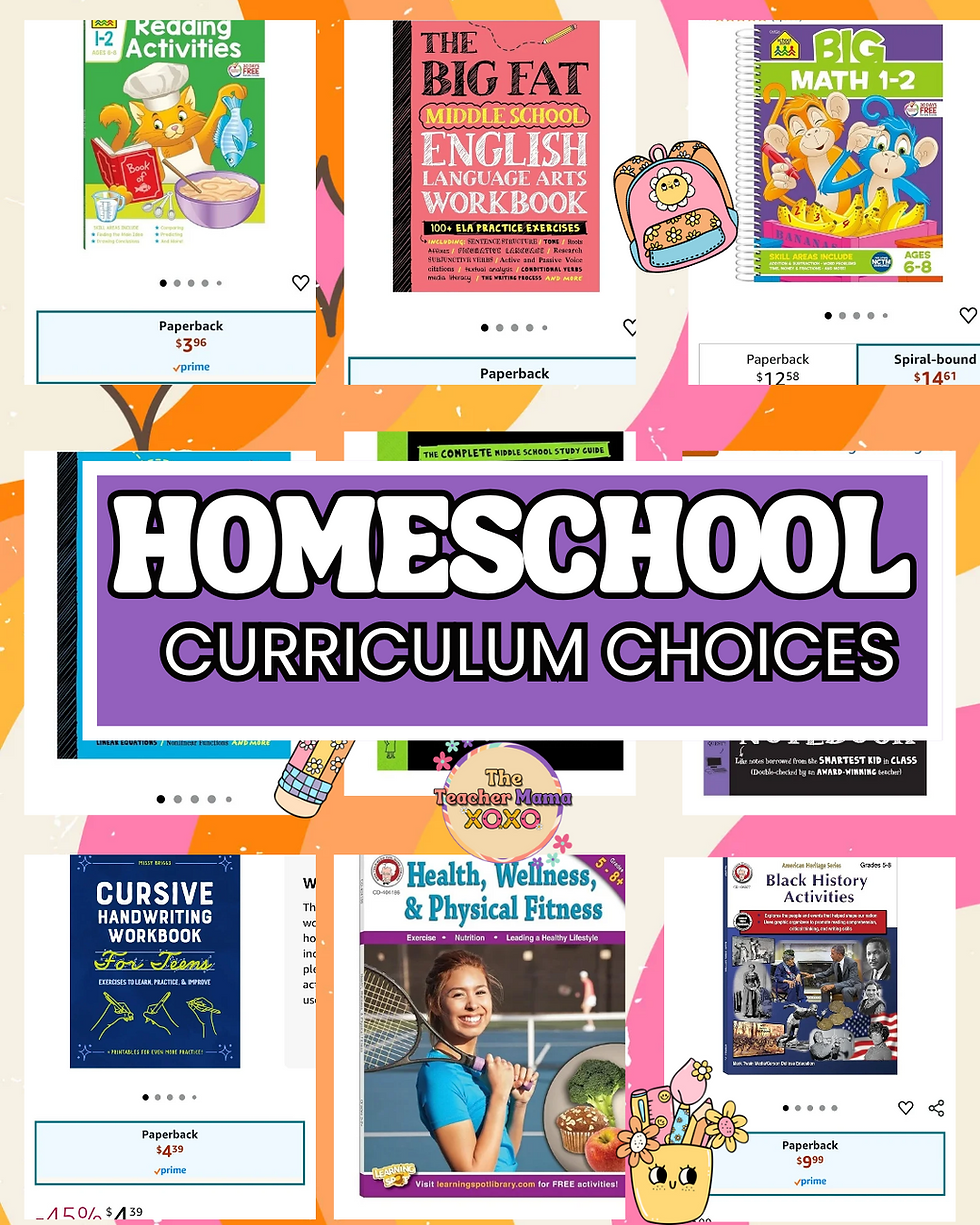I Spent $85.55 on Homeschool Books and Didn’t Immediately Regret It (Shockingly)
- TheTeacherMama.XO

- Aug 5
- 4 min read

Welcome to my living room—a mystical space where coffee mugs multiply, socks disappear,
and my two daughters (ages 6 and 12) occasionally reenact historical moments using cardboard swords and glitter glue.
I’m Kimmy, also known as TheTeacherMama.Xoxo, former early childhood and elementary teacher turned homeschool mom, lesson plan wrangler, snack negotiator, and budget curriculum sorceress.
This year, I spent exactly $85.55 on curriculum books for our 2025–2026 homeschool adventure. For two kids. Two grade levels. An entire year. That’s less than what I used to spend on silent reading timers that beeped at emotionally unpredictable intervals.
Real Teacher. Real Mom. Real Reasons I Bought These Books
These weren’t impulse buys while stress-snacking and scrolling Amazon. These were strategic picks to give us quality, flexibility, and just enough structure so I don’t have to reinvent learning every Monday. And yes—I created pacing guides for every subject to help us stay focused throughout the year. I know. I deserve a medal or at least a guilt-free nap.
The Book Haul Breakdown: Why Each One Earned a Spot
For My 1st Grader (Age 6, Future CEO of Sparkle and Sass)
Evan-Moor Skill Sharpeners Science Workbook, Grade 1🧪
Covers everything from weather to technology (and includes songs, because this child will absolutely sing about the water cycle in Broadway style). Easy to slot into weekly themes with clear pacing.
School Zone Reading Activities 1–2 Workbook📚
Comprehension skills like comparing, contrasting, and definitely pretending the bear went into the cave for snacks. Used in short bursts, aligned with our scope and sequence.
School Zone Big Math Workbook 1–2➗
Addition, subtraction, fractions, time, and money. With 320 pages, it doubles as both curriculum and leg workout if I have to haul it somewhere. Mapped across 36 weeks in our pacing guide to prevent "Math Sadness Fridays."
For My 7th Grader (Age 12, Master of Debate and Mild Eye Rolls)
Everything You Need to Ace Computer Science and Coding💻
She now uses phrases like “binary logic,” and I pretend to understand. Weekly pacing tied to Khan Academy’s free computer science units.
Big Fat Middle School Math Workbook: 600 Exercises📊
Six hundred practice pages. She views it as a challenge. I view it as my cardio when I chase her for page completion. Our pacing guide breaks this massive book into weekly review chunks.
Cursive Handwriting Workbook for Teens✍️
Because writing "thank you" notes in Arial 12 just doesn’t hit the same. Slotted twice a week during "semi-quiet moments" (a homeschool myth, I know).
Big Fat ELA Workbook + Big Fat Science Workbook (twice... because ADHD is strong)📚 These do the heavy lifting for science and English. Everything is chunked clearly and review-friendly. My pacing guide blends them with our thematic units and supplements from free resources. I also use digital resources to provide a different way of learning. I pride myself on providing wonderful blended learning opportunities for my children.
Black History Activities Workbook✊🏽
Slavery, Reconstruction, civil rights—all with meaningful, digestible lessons. Integrated into our social studies pacing plan and paired with field trips when possible. It is very important to me that my children learn our cultural history.
How These Books Work with My Frankenstein Curriculum Method™
I cherry-pick between free online curriculums depending on the week’s theme, the girls’ moods, and how strongly the coffee hits:
Core Knowledge & Discovery K12 – solid and robust curriculum skeletons
The Good and The Beautiful – dreamy handwriting and moral wholesomeness
Fishtank Learning – strong ELA and math where I need support
Freedom Homeschooling, Ambleside Online, Sherlock Homeschooling – rich reading, history, and the occasional rabbit hole of primary sources
Khan Academy – especially for when I pretend I’m not googling math behind the scenes
But none of it works without structure. That’s where my pacing guides come in. I broke down each subject into weekly blocks with built-in flexibility, field trip tie-ins, and realistic expectations. These guides keep us on track and help me pivot when someone wakes up in a mood that can only be calmed by an impromptu poetry slam or backyard science experiment.
The Cherry on Top: Field Trips as Learning Extensions
Our pacing guides aren’t just desk-bound—they’re woven with plans for weekly field trips:
National parks for science exploration and personal space
Museums to make history tactile and mildly chaotic
Library escapades to track down books about volcanoes or ancient civilizations (or both—thank you, cross-curricular themes)
Real-world learning keeps the pace fresh, meaningful, and makes homeschool feel less like worksheets and more like memory-making. Also, bonus: it lowers the whining ratio by about 20%.
Final Thoughts: Why I’m Sticking With This Budget-Friendly Plan
These books aren’t just filler—they’re flexible, valuable, and downright useful when used alongside thoughtfully curated pacing guides and free resources. They’re easy to implement, easy to adapt, and they give me just enough breathing room to teach, plan, parent, and occasionally eat lunch sitting down.
If you're a homeschooler feeling overwhelmed by the sea of expensive curriculum packages with words like “multi-level,” “cohort,” or “bundle pricing,” let me just say—you don’t need all that. You just need clarity, pacing, and the courage to believe $85.55 can go a long way.
I’m doing it. The girls are thriving. And my coffee is still lukewarm, but my resolve is hot.
Let’s make this year the most structured chaos we’ve ever had. Let’s homeschool boldly—on budget, with brains, and pacing guides made of pure determination.





Comments